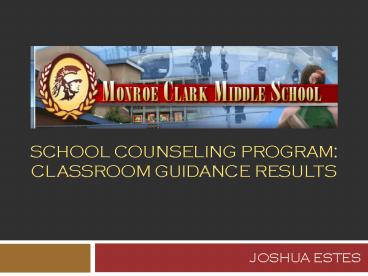SCHOOL COUNSELING PROGRAM: CLASSROOM GUIDANCE RESULTS - PowerPoint PPT Presentation
1 / 17
Title:
SCHOOL COUNSELING PROGRAM: CLASSROOM GUIDANCE RESULTS
Description:
Cyberbullying. Why is this lesson needed? ... against cyberbullying. Pre. 36 ... Add cyberbullying component to existing bullying prevention programs. ... – PowerPoint PPT presentation
Number of Views:757
Avg rating:3.0/5.0
Title: SCHOOL COUNSELING PROGRAM: CLASSROOM GUIDANCE RESULTS
1
SCHOOL COUNSELING PROGRAMCLASSROOM GUIDANCE
RESULTS
- JOSHUA ESTES
2
ASCA National Standards
- Personal Social Standard A
- Students will acquire the knowledge, attitudes,
and interpersonal skills to help them understand
and respect self and others. - Personal Social Standard B
- Students will make decisions, set goals, and
take necessary action to achieve goals. - Personal Social Standard C
- Students will understand safety and survival
skills.
3
ASCA Student Competency
- PSA1.6 Distinguish between appropriate and
inappropriate behavior. - PS A1.8 Understand the need for self control
and how to practice it. - PS B1.5 Demonstrate when, where, and how to
seek help for solving problems and making
decisions. - PS C1.2 Learn about the relationship between
rules, laws, safety, and the protection of rights
of the individual.
4
Classroom Guidance Curriculum
- 6th grade students
- Presentation to 100 students
- October 2008
- Lesson content
- Staying safe from online predators
- Proper online behavior
- Cyberbullying
5
Why is this lesson needed?
- Relationship between harassment occurring
electronically (internet, text messaging, etc.)
and on school grounds. i - Bash book circulated among students online
during the 2007-2008 school year led to in-school
peer conflict. i - According to the Teen Internet Safety Study, 71
of students reported receiving messages online
from someone they do not know. ii - i. Communication with Monroe Clark Middle School
School Resource Officer, December 2008. - ii. http//www.netsmartz.org/safety/statistics.htm
, retrieved November 15, 2008.
6
What do students believe?
- I believe it is a good idea to share personal
information online with someone I have never
met. - Pre
- 54 Strongly Disagreed
- 30 Disagreed
- Post
- 67 Strongly Disagreed
- 21 Disagreed
7
What do students believe?
- It is okay to give my friends e-mail addresses
out without their permission. - Pre
- 29 Strongly Disagreed
- 59 Disagreed
- Post
- 51 Strongly Disagreed
- 38 Disagreed
Thats a 76 increase!
8
What do students know?
- Students were asked to
- identify what an online
- predator is.
- Pre
- 59 Answered correctly
- Post
- 74 Answered correctly
9
What do students know?
- Students were asked to
- identify proper strategies to
- protect themselves
- against cyberbullying.
- Pre
- 36 Identified proper strategies
- Post
- 50 Identified proper strategies
10
What Can Students Do?
- Students were asked to
- demonstrate the proper methods
- for handling hostile online
- situations.
- Pre
- 32 Identified the proper methods
- Post
- 49 Identified the proper methods
11
What the research shows
- Bullying affects students academically, socially,
and psychologically. - Bullying has dramatically
- altered school climates
- nationwide.
- McAdams, C. R., Schmidt, C. D. (2007)
- How to Help a Bully Recommendations for
Counseling the Proactive Aggressor. - Professional School Counseling, 11(2), 120-128.
12
Achievement Related Data
- During the 2007-2008 school year, there were 13
referrals for bullying. - In the time following the classroom guidance
lessons (October 18, 2008 December 17, 2008),
there have been two.
13
Limitations/Lessons Learned
- Pre/post questions may be difficult for English
language learners to understand. - A high number of students already knew what a
cyberbully is therefore, more time could be
given to learning new concepts. - Overall, many students were still unsure if they
would tell an adult if something happened to them
online.
14
Recommendations
- Administer needs assessment prior to creating
lesson. - Use separate Scantron sheet for pre and post
test. - Consider having a Cybersafety Awareness Week at
school. - Add cyberbullying component to existing bullying
prevention programs. - Continue to build trusting relationships between
school staff and students.
15
Next Steps
- Collect bullying/harassment referral data for the
entire 2008-2009 school year. - Follow up with School Resource Officer about
instances of online bullying/harassment.
16
Thank you for your support!
- The school counseling program is contributing in
a meaningful way to the personal/social
development and academic achievement of all
students.
17
References
- http//www.netsmartz.org/safety/statistics.htm,
retrieved November 15, 2008. - McAdams, C. R., Schmidt, C. D. (2007) How to
Help a Bully Recommendations for Counseling the
Proactive Aggressor. Professional School
Counseling, 11(2), 120-128.































